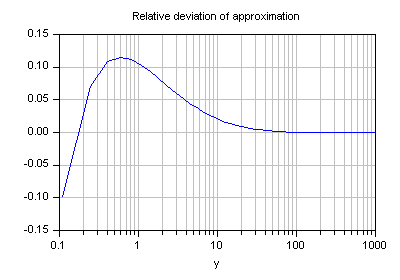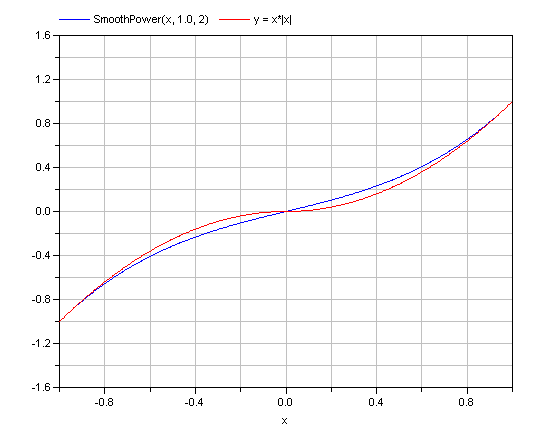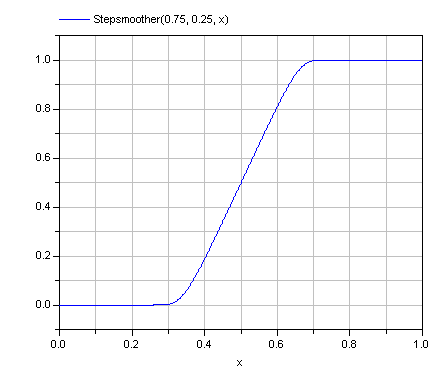| Name | Description |
|---|---|
| Closed approximation of lambert's w function for solving f(x) = x exp(x) for x | |
| Iterative form of lambert's w function for solving f(x) = x exp(x) for x | |
| calculation of Prandtl number | |
| calculation of Reynolds number | |
| Limiting the derivative of function y = if x>=0 then x^pow else -(-x)^pow | |
| The derivative of function SmoothPower | |
| Continuous interpolation for x | |
| Derivative of function Stepsmoother |
| Type | Name | Default | Description |
|---|---|---|---|
| Real | Re_turbulent | ||
| ReynoldsNumber | Re1 | [1] | |
| ReynoldsNumber | Re2 | [1] | |
| Real | Delta | ||
| Real | lambda2 |
| Type | Name | Description |
|---|---|---|
| ReynoldsNumber | Re | [1] |
function CubicInterpolation_DP import Modelica.Math; input Real Re_turbulent; input SI.ReynoldsNumber Re1; input SI.ReynoldsNumber Re2; input Real Delta; input Real lambda2; output SI.ReynoldsNumber Re; // point lg(lambda2(Re1)) with derivative at lg(Re1) protected Real x1=Math.log10(64*Re1); Real y1=Math.log10(Re1); Real yd1=1; // Point lg(lambda2(Re2)) with derivative at lg(Re2) Real aux1=(0.5/Math.log(10))*5.74*0.9; Real aux2=Delta/3.7 + 5.74/Re2^0.9; Real aux3=Math.log10(aux2); Real L2=0.25*(Re2/aux3)^2; Real aux4=2.51/sqrt(L2) + 0.27*Delta; Real aux5=-2*sqrt(L2)*Math.log10(aux4); Real x2=Math.log10(L2); Real y2=Math.log10(aux5); Real yd2=0.5 + (2.51/Math.log(10))/(aux5*aux4); // Constants: Cubic polynomial between lg(Re1) and lg(Re2) Real diff_x=x2 - x1; Real m=(y2 - y1)/diff_x; Real c2=(3*m - 2*yd1 - yd2)/diff_x; Real c3=(yd1 + yd2 - 2*m)/(diff_x*diff_x); Real lambda2_1=64*Re1; Real dx=Math.log10(lambda2/lambda2_1); algorithm Re := Re1*(lambda2/lambda2_1)^(1 + dx*(c2 + dx*c3));end CubicInterpolation_DP;
| Type | Name | Default | Description |
|---|---|---|---|
| ReynoldsNumber | Re | [1] | |
| ReynoldsNumber | Re1 | [1] | |
| ReynoldsNumber | Re2 | [1] | |
| Real | Delta |
| Type | Name | Description |
|---|---|---|
| Real | lambda2 |
function CubicInterpolation_MFLOW import Modelica.Math; input SI.ReynoldsNumber Re; input SI.ReynoldsNumber Re1; input SI.ReynoldsNumber Re2; input Real Delta; output Real lambda2; // point lg(lambda2(Re1)) with derivative at lg(Re1) protected Real x1=Math.log10(Re1); Real y1=Math.log10(64*Re1); Real yd1=1; // Point lg(lambda2(Re2)) with derivative at lg(Re2) Real aux1=(0.5/Math.log(10))*5.74*0.9; Real aux2=Delta/3.7 + 5.74/Re2^0.9; Real aux3=Math.log10(aux2); Real L2=0.25*(Re2/aux3)^2; Real aux4=2.51/sqrt(L2) + 0.27*Delta; Real aux5=-2*sqrt(L2)*Math.log10(aux4); Real x2=Math.log10(Re2); Real y2=Math.log10(L2); Real yd2=2 + 4*aux1/(aux2*aux3*(Re2)^0.9); // Constants: Cubic polynomial between lg(Re1) and lg(Re2) Real diff_x=x2 - x1; Real m=(y2 - y1)/diff_x; Real c2=(3*m - 2*yd1 - yd2)/diff_x; Real c3=(yd1 + yd2 - 2*m)/(diff_x*diff_x); Real dx=Math.log10(Re/Re1); algorithm lambda2 := 64*Re1*(Re/Re1)^(1 + dx*(c2 + dx*c3));end CubicInterpolation_MFLOW;
This function calculates an approximation of the inverse for
f(x) = y = x * exp( x )
within ∞ > y > -1/e. The relative deviation of this approximation for lambert's w function x = W(y) is diplayed in the following graph.

For y > 10 and higher values the relative deviation is smaller 2%.
| Type | Name | Default | Description |
|---|---|---|---|
| Real | y | f(x) |
| Type | Name | Description |
|---|---|---|
| Real | x | W(y) |
function LambertW
"Closed approximation of lambert's w function for solving f(x) = x exp(x) for x"
input Real y "f(x)";
output Real x "W(y)";
protected
Real xl;
algorithm
if (y <= 500.0) then
xl := Modelica.Math.log(y + 1.0);
x := 0.665*(1 + 0.0195*xl)*xl + 0.04;
else
xl := 0;
x := Modelica.Math.log(y - 4.0) - (1.0 - 1.0/Modelica.Math.log(y))*
Modelica.Math.log(Modelica.Math.log(y));
end if;
assert(y > -1/Modelica.Math.exp(1),
"Lambert-w-function is only valid for inputs y > -1/Modelica.Math.exp(1)!");
end LambertW;
This function calculates an approximation of the inverse for
f(x) = y = x * exp( x )
within ∞ > y > -1/e. Please note, that for negative inputs two solutions exists. The function currently delivers the result x = -1 ... 0 for that particular range.
| Type | Name | Default | Description |
|---|---|---|---|
| Real | y | f(x) |
| Type | Name | Description |
|---|---|---|
| Real | x | W(y) |
| Integer | iter |
function LambertWIter
"Iterative form of lambert's w function for solving f(x) = x exp(x) for x"
input Real y "f(x)";
output Real x "W(y)";
output Integer iter;
protected
Real w;
Real prec=1e-12;
Real c1;
Real c2;
Real dw;
Real w1;
/*Real wTimesExpW;
Real wPlusOneTimesExpW;*/
Real dev;
Integer i;
algorithm
w := if y > 0.1 then Modelica.Fluid.Dissipation.Utilities.Functions.General.LambertW(
y) else sqrt(5.43656*max(y, -1/Modelica.Math.exp(1)) + 2) - 1;
dev := 1;
i := 0;
while prec < dev and i < 100 loop
/*wTimesExpW := w*Modelica.Math.exp(w);
wPlusOneTimesExpW := (w+1)*Modelica.Math.exp(w);
w := w-(wTimesExpW-y)/(wPlusOneTimesExpW-(w+2)*(wTimesExpW-y)/(2*w+2));
dev := abs((y-wTimesExpW)/wPlusOneTimesExpW);
i := i+1;*/
c1 := Modelica.Math.exp(w);
c2 := w*c1 - y;
w1 := if w <> 1 then w + 1 else w;
dw := c2/(c1*w1 - ((w + 2)*c2/(2*w1)));
w := w - dw;
//dev := abs(dw)/(2+abs(w));
dev := abs((y - w*c1)/(w + 1)*c1);
i := i + 1;
end while;
x := w;
iter := i;
end LambertWIter;
| Type | Name | Default | Description |
|---|---|---|---|
| SpecificHeatCapacityAtConstantPressure | cp | specific heat capacity of fluid at constant pressure [J/(kg.K)] | |
| DynamicViscosity | eta | dynamic viscosity of fluid [Pa.s] | |
| ThermalConductivity | lambda | thermal conductivity of fluid [W/(m.K)] |
| Type | Name | Description |
|---|---|---|
| PrandtlNumber | Pr | Prandtl number [1] |
function PrandtlNumber "calculation of Prandtl number"
import SI = Modelica.SIunits;
import MIN = Modelica.Constants.eps;
//fluid properties
input SI.SpecificHeatCapacityAtConstantPressure cp
"specific heat capacity of fluid at constant pressure";
input SI.DynamicViscosity eta "dynamic viscosity of fluid";
input SI.ThermalConductivity lambda "thermal conductivity of fluid";
output SI.PrandtlNumber Pr "Prandtl number";
algorithm
Pr := eta*cp/max(MIN, lambda);
end PrandtlNumber;
| Type | Name | Default | Description |
|---|---|---|---|
| Area | A_cross | Cross sectional area [m2] | |
| Length | perimeter | Wetted perimeter [m] | |
| Density | rho | Density of fluid [kg/m3] | |
| DynamicViscosity | eta | Dynamic viscosity of fluid [Pa.s] | |
| MassFlowRate | m_flow | Mass flow rate [kg/s] |
| Type | Name | Description |
|---|---|---|
| ReynoldsNumber | Re | Reynolds number [1] |
| Velocity | velocity | Mean velocity [m/s] |
function ReynoldsNumber "calculation of Reynolds number" import SI = Modelica.SIunits; import MIN = Modelica.Constants.eps; //geometry input SI.Area A_cross "Cross sectional area"; input SI.Length perimeter "Wetted perimeter"; //fluid properties input SI.Density rho "Density of fluid"; input SI.DynamicViscosity eta "Dynamic viscosity of fluid"; input SI.MassFlowRate m_flow "Mass flow rate"; output SI.ReynoldsNumber Re "Reynolds number"; output SI.Velocity velocity "Mean velocity"; protected SI.Diameter d_hyd=4*A_cross/max(MIN, perimeter) "Hydraulic diameter"; algorithm Re := 4*abs(m_flow)/max(MIN, (perimeter*eta)); velocity := m_flow/max(MIN, (rho*A_cross));end ReynoldsNumber;
 Modelica.Fluid.Dissipation.Utilities.Functions.General.SmoothPower
Modelica.Fluid.Dissipation.Utilities.Functions.General.SmoothPower
The function is used to limit the derivative of the following function at x=0:
y = if x ≥ 0 then xpow else -(-x)pow; // pow > 0
by approximating the function in the range -deltax< x < deltax with a third order polynomial that has the same derivative at abs(x)=deltax, as the function above.
In the picture below the input x is increased from -1 to 1. The range of interpolation is defined by the same range. Displayed is the output of the function SmoothPower compared to
y=x*|x|For |x| > 1 both functions return identical results.

Extends from Modelica.Icons.Function (Icon for functions).
| Type | Name | Default | Description |
|---|---|---|---|
| Real | x | input variable | |
| Real | deltax | range for interpolation | |
| Real | pow | exponent for x |
| Type | Name | Description |
|---|---|---|
| Real | y | output variable |
function SmoothPower
"Limiting the derivative of function y = if x>=0 then x^pow else -(-x)^pow"
annotation(derivative=SmoothPower_der);
extends Modelica.Icons.Function;
input Real x "input variable";
input Real deltax "range for interpolation";
input Real pow "exponent for x";
output Real y "output variable";
protected
Real adeltax=abs(deltax);
Real C3=(pow - 1)/2*adeltax^(pow - 3);
Real C1=(3 - pow)/2*adeltax^(pow - 1);
algorithm
y := if x >= adeltax then x^pow else if x <= -adeltax then -(-x)^pow else (C1
+ C3*x*x)*x;
end SmoothPower;
 Modelica.Fluid.Dissipation.Utilities.Functions.General.SmoothPower_der
Modelica.Fluid.Dissipation.Utilities.Functions.General.SmoothPower_der
| Type | Name | Default | Description |
|---|---|---|---|
| Real | x | input variable | |
| Real | deltax | range of interpolation | |
| Real | pow | exponent for x | |
| Real | dx | derivative of x | |
| Real | ddeltax | derivative of deltax | |
| Real | dpow | derivative of pow |
| Type | Name | Description |
|---|---|---|
| Real | dy | derivative of SmoothPower |
function SmoothPower_der "The derivative of function SmoothPower"
extends Modelica.Icons.Function;
input Real x "input variable";
input Real deltax "range of interpolation";
input Real pow "exponent for x";
input Real dx "derivative of x";
input Real ddeltax "derivative of deltax";
input Real dpow "derivative of pow";
output Real dy "derivative of SmoothPower";
protected
Real C3;
Real C1;
Real adeltax;
algorithm
adeltax := abs(deltax);
if noEvent(x >= adeltax) then
dy := dx*pow*x^(pow - 1);
elseif noEvent(x <= -adeltax) then
dy := -dx*pow*(-x)^(pow - 1);
else
C3 := (pow - 1)/2*adeltax^(pow - 3);
C1 := (3 - pow)/2*adeltax^(pow - 1);
dy := (C1 + 3*C3*x*x)*dx;
end if;
end SmoothPower_der;
 Modelica.Fluid.Dissipation.Utilities.Functions.General.Stepsmoother
Modelica.Fluid.Dissipation.Utilities.Functions.General.Stepsmoother
The function is used for continuous fading of variable inputs within a defined range. It allows a differentiable and smooth transition between function outputs, e.g., laminar and turbulent pressure drop or correlations for certain ranges.
The tanh-function is used, since it provides an existing derivative and the derivative is zero at the borders [nofunc, func] of the interpolation domain (smooth derivative for transitions).
In order to work correctly, the internal interpolation range in terms of the external arbitrary input x needs to be scaled such that:
f(func) = 0.5 π f(nofunc) = -0.5 π
In the picture below the input x is increased from 0 to 1. The range of interpolation is defined by:

Extends from Modelica.Icons.Function (Icon for functions).
| Type | Name | Default | Description |
|---|---|---|---|
| Real | func | input value for that result = 100% | |
| Real | nofunc | input value for that result = 0% | |
| Real | x | input variable for continuous interpolation |
| Type | Name | Description |
|---|---|---|
| Real | result | output value |
function Stepsmoother "Continuous interpolation for x "
annotation(derivative=Stepsmoother_der);
extends Modelica.Icons.Function;
input Real func "input value for that result = 100%";
input Real nofunc "input value for that result = 0%";
input Real x "input variable for continuous interpolation";
output Real result "output value";
protected
Real m=Modelica.Constants.pi/(func - nofunc);
Real b=-Modelica.Constants.pi/2 - m*nofunc;
Real r_1=tan(m*x + b);
algorithm
result := if x >= 0.999999*(func - nofunc) + nofunc and func > nofunc or x
<= 0.999999*(func - nofunc) + nofunc and nofunc > func then 1 else if x
<= 0.000001*(func - nofunc) + nofunc and func > nofunc or x >= 0.000001*(
func - nofunc) + nofunc and nofunc > func then 0 else ((0.5*(exp(r_1) - exp(
-r_1))/(0.5*(exp(r_1) + exp(-r_1))) + 1)/2);
end Stepsmoother;
 Modelica.Fluid.Dissipation.Utilities.Functions.General.Stepsmoother_der
Modelica.Fluid.Dissipation.Utilities.Functions.General.Stepsmoother_der
| Type | Name | Default | Description |
|---|---|---|---|
| Real | func | input for that result = 100% | |
| Real | nofunc | input for that result = 0% | |
| Real | x | input for interpolation | |
| Real | dfunc | derivative of func | |
| Real | dnofunc | derivative of nofunc | |
| Real | dx | derivative of x |
| Type | Name | Description |
|---|---|---|
| Real | dresult |
function Stepsmoother_der "Derivative of function Stepsmoother"
extends Modelica.Icons.Function;
input Real func "input for that result = 100%";
input Real nofunc "input for that result = 0%";
input Real x "input for interpolation";
input Real dfunc "derivative of func";
input Real dnofunc "derivative of nofunc";
input Real dx "derivative of x";
output Real dresult;
protected
Real m=Modelica.Constants.pi/(func - nofunc);
Real b=-Modelica.Constants.pi/2 - m*nofunc;
algorithm
dresult := if x >= 0.999*(func - nofunc) + nofunc and func > nofunc or x <=
0.999*(func - nofunc) + nofunc and nofunc > func or x <= 0.001*(func -
nofunc) + nofunc and func > nofunc or x >= 0.001*(func - nofunc) + nofunc
and nofunc > func then 0 else (1 - Modelica.Math.tanh(Modelica.Math.tan(m*
x + b))^2)*(1 + Modelica.Math.tan(m*x + b)^2)*m*dx;
end Stepsmoother_der;